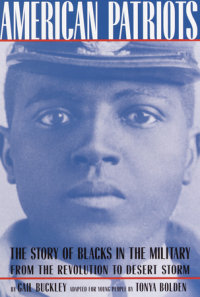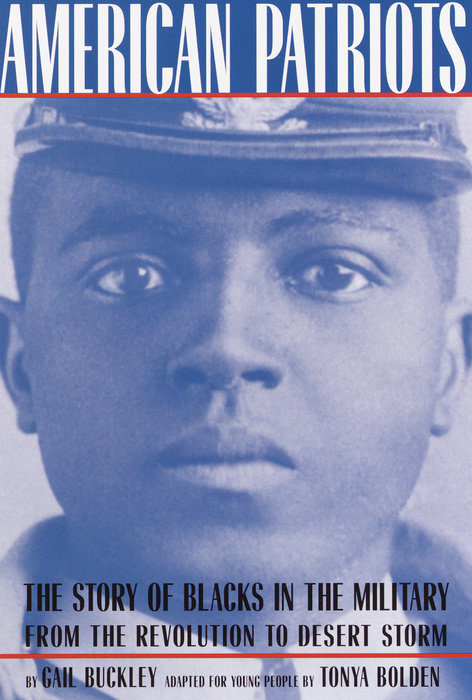American Patriots: A Young People's Edition
They fought on Lexington Green the first morning of the Revolution and survived the bitter cold winter at Valley Forge. They stormed San Juan Hill with Theodore Roosevelt’s Rough Riders and manned an anti-aircraft gun at Pearl Harbor. They are the black Americans who fought, often in foreign lands, for freedoms that they did not enjoy at home.
Adapted for young readers, this dramatic story brings to life the heroism of people such as Crispus Attucks, Benjamin O. Davis, Charity Adams, and Colin Powell, and captures the spirit that drove these Americans to better their lives and demand of themselves the highest form of sacrifice.
An Excerpt fromAmerican Patriots: A Young People's Edition
The Revolution
I served in the Revolution, in General Washington's army. . . . I have stood in battle, where balls, like hail, were flying all around me. The man standing next to me was shot by my side--his blood spouted upon my clothes, which I wore for weeks. My nearest blood, except that which runs in my veins, was shed for liberty. My only brother was shot dead instantly in the Revolution. Liberty is dear to my heart--I cannot endure the thought, that my countrymen should be slaves.
--"Dr. Harris," a veteran of the 1st Rhode Island, in an address to an anti-slavery society in Francestown, New Hampshire, 1842
By 1770, Crispus Attucks, the son of an African father and a Native American mother, had spent some twenty years at sea, having escaped slavery in Framingham, Massachusetts, when he was about twenty-seven years old.
On the night of March 5, 1770, Attucks was in Boston's King Street tavern when an alarm bell was heard from the street's British sentry. When Attucks led a stick- and bat-wielding group of fellows from the tavern, he discovered that the sentry was under "attack" only from snowball-throwing boys. Still, Attucks and his mob took the side of the boys against the Redcoats--using heavy sticks instead of snowballs. Witnesses said that Attucks, striking the first blow, caused arriving British soldiers to open fire. British musket shots hit eleven people, killing five: four white men and Crispus Attucks--the first to die, from two shots to the chest.
Some Bostonians had little regard for the victims. In his defense of the British soldiers, lawyer John Adams blamed Attucks for the mini riot, dismissing him as a rabble-rouser--
the leader of a gang of lowlifes and rowdies. The merchant John Hancock, like Adams a future signer of the Declaration of
Independence, also accused Attucks of provoking the "Boston Massacre"--but from a praiseworthy point of view. "Who taught the British soldier that he might be defeated?" Hancock later asked. "Who dared look into his eyes? I place, therefore, this Crispus Attucks in the foremost rank of the men that dared."
Although the British soldiers were acquitted from any wrongdoing, the Americans won the lion's share of public support and sympathy. Crispus Attucks and his companions became the first popular martyrs of the Revolution.
By the time of the Boston Massacre, Britain controlled North America from the Atlantic Ocean to the Mississippi River, as well as most of the islands that made up the West Indies. The debt Britain had incurred securing much of this territory during the French and Indian Wars (1689-1763) had led to heavy taxation of the thirteen colonies, which, in British eyes, existed only for the benefit of the mother country. The thirteen colonies, with a budding sense of nationhood, saw any form of taxation as slavery. The mother country's Sugar Act, Stamp Act, and other acts of taxation sparked bold acts of defiance, such as the "Boston Tea Party" on the night of December 16, 1773.
Black people also engaged in protest--against slavery. In 1773, Massachusetts courts and legislature saw several petitions from enslaved blacks, asking for their freedom along with, in one case, some "unimproved land" on which to build new lives. At the time, out of a total population of 2,600,000, in Britain's North American colonies, there were roughly 500,000 black people, with about 460,000 of them enslaved.
Quaker Philadelphia was the heart of early eighteenth-century abolitionism. Benjamin Franklin was among that city's early abolitionists. Anthony Benezet was another. "How many of those who distinguish themselves as Advocates of Liberty remain insensible," Benezet wrote in a 1766 pamphlet, "to the treatment of thousands and tens of thousands of our fellow men, who . . . are at this very time kept in the most deplorable state of slavery."
By the mid-1770s, Boston was the center of abolition as well as revolution. "No country can be called free where there is one slave," declared James Swan, a Boston merchant who had participated in the Boston Tea Party.
"It has always appeared a most iniquitous scheme to me," wrote Abigail Adams, in the summer of 1774, to her husband, John, "to fight ourselves for what we are daily robbing and plundering from those who have as good a right to freedom as we have." By "we" Abigail was referring to the American colonies--not the Adams family, for they were not slaveholders. When Abigail wrote this letter, she was at home in Braintree, Massachusetts. John was in Philadelphia, at the First Continental Congress, where representatives from the colonies (except for Georgia) were meeting to discuss their grievances against Britain and ways to get them remedied.
By the spring of 1775, armed revolt seemed the only remedy to many. On March 23, at a convention in Richmond, Virginia, Patrick Henry, a slaveholder, raised the American battle cry with "Give me liberty or give me death!" By then, having anticipated trouble, the British had increased their troops in Boston. These troops were under the command of General Thomas Gage, who was also Royal Governor of Massachusetts.
New England towns and villages had been preparing for war since the winter of 1774. Weapons and gunpowder had been stored. Militiamen were armed and ready, as were Minutemen, an elite militia that could be "ready in a minute" and were organized after the Boston Tea Party. By April 1775, there was a growing number of Patriots ready to do battle against Britain--and with colonists who sided with the mother country, the Loyalists, also known as Tories.
In April 1775, British intelligence learned that a secret meeting in Concord of the illegal Massachusetts Congress had determined to establish an army. On April 18, General Gage ordered troops to proceed to Concord to seize all weapons and ammunition. An advance guard was also sent to Lexington because of similar rumors about an insurrection there.
As British soldiers left by boat across Back Bay late on the night of April 18, two signal lamps ("One if by land, two if by sea") were hung in the steeple of the Old North Church. The printer and silversmith Paul Revere was silently rowed across the Charles River, which was being watched by a heavily armed British warship. Once on shore, Revere mounted one of the fastest horses in the colony to warn first Lexington and then Concord that the British were coming.
In Lexington, Revere, by then joined by two other couriers, was briefly stopped by a British patrol, to whom he supplied "information," with a gun to his head. Armed with Revere's "information," the British patrol told their commanders that at least five hundred Minutemen were waiting on Lexington Green.
The several hundred British soldiers who approached the green early the next morning found a motley army of seventy-seven militiamen. The British Major Pitcairn ordered his troops not to fire and told the Americans to drop their weapons and
disperse. Lexington's militia, led by Captain John Parker, was not eager for battle, either. But just as Parker gave the order to withdraw, someone's musket fired (whether American or British is unknown). Scattered shots from both sides followed that first mysterious shot. Eight Americans died and nine were wounded before the shooting stopped.
Prince Easterbrooks, a Lexington slave, was one of the Americans who fought in Captain Parker's company in that first battle of the Revolution--a battle that lasted about fifteen minutes. Easterbrooks was also in the next quick (about five minutes) fight later that same morning: the Battle of Concord.
Entering Concord without resistance at around eight o'clock in the morning, the British found some four hundred Minutemen waiting at North Bridge. There's no mystery as to who fired first here: the British. The Patriots' return fire became known as the "shot heard round the world."
Three British and two Americans were killed before the Americans retreated, with many others from both sides wounded. Prince Easterbrooks, who was among the wounded, was not the only black Massachusetts militiaman defending North Bridge that day. The others included Peter Salem, of Framingham, who had been freed from slavery to enlist; Samuel Craft, of Newton; Caesar Ferrit and his son John, of Natick; and men known only by first names--Pompy, of Braintree (now Quincy), and Prince, of Brookline. Another black Patriot was Lemuel Haynes, who would become the first black ordained Congregational minister in America.

